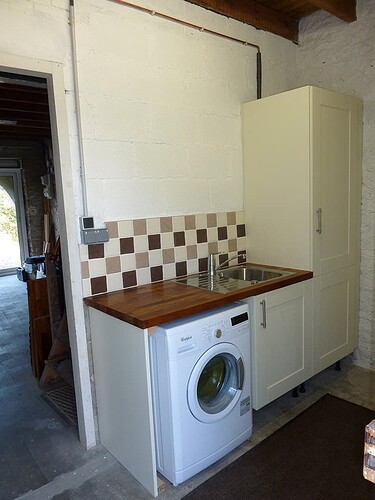If only it was only every year ![]()
Looks very nice indeed. I too opted for white units with a few neutral wooden doors added and black handles. Coloured kitchens date and white always stays in fashion. Just got to do the splashback tiles and fit a hotte now when I have saved enough.
Cunning trick to avoid that, dispensing with tape measures to mis-read.
If the w/top came in a cardboard carton, cut it down to one complete side and offer that up as a template. Butt up to one end, trim off at the exact point at the other, + 6mm, where it passes over the cab, next to the next cab/cooker w.h.y. where the join is gonna be. Tape it to the w/top. Make your cut.
Or use roll of any kind of paper/tape. Use as above.
Cunning trick to avoid that, dispensing with tape measures to mis-read.
If the w/top came in a cardboard carton, cut it down to one complete side and offer that up as a template. Butt up to one end, mark off the exact point at the other, where it passes over the cab, next to the next cab/cooker w.h.y. where the join is gonna be.
Or use roll of any kind of paper/tape. Use as above.
The old adage, measure, measure and measure again ![]()
First thing the old boy who I started my apprenticeship with told me - Measure twice - cut once.
He also taught me never to cut towards your thumb, always cut towards your chum!
Can’t even see the joint, good work.
It’s pretty obvious, though the photo hides it well but you’ll spot it if you zoom in.
I was furious with myself, I’d just ruined a very expensive piece of wood and I couldn’t immediately see how to fix the problem - cutting an extra 10cm is one thing, but you can’t really join 10cm onto the end of a bit of worktop - the cutouts underneath for the tie rods are about that length on each side.
In the end I realised I could re-join the worktop along the cut I made, then make the “to length” cut at the other end.
Normally you woldn’t want a join in the unsupported span, but I didn’t have much choice. It’s not totally unsupported though - there’s a bit of 2x2 running under the far edge.
Fortunately it was the utility rather than the kitchen itself.
My advice to anybody planning a renovation project.
If doing it by a pro, calculate the time you think it will take and then double it.
If doing it yourself, calculate the time you think it will take and then quadruple it !!
And take the same approach to cost.
Are all the worktops solid wood ? If so, then they are, appropriately called ‘butcher blocks’ ![]()
Iroko.
An African butcher block then ![]()
One of my first jobs as an apprentice was making draining boards from Iroko.
Being extremely hard wearing it was/and probably still is often used as tongue and grove boarding in motor body manufacture specifically for the carrying area of flat bed vabs abd lorries. Doesn’t require any treatment but can leak resin for a long time.
I used Iroko worktops in our kitchen in the UK.
Moderately happy with them.
Wish I’d used solid teak instead, but money was tight.
I have iroko garden furniture - now 27 years old and still in excellent condition in spite of not being treated for 10 years or so.
Almost twenty years I lived in my house full-time, & not one room is finished.
I’m glad to hear that it’s not just me in that position ![]()
Or me…
It still looks like I just moved in a week ago…
